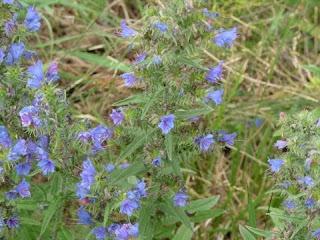









In recent years I have been able to spend a few days each summer with my uncle and aunt in my original hometown of Bluefield, West Virginia, reliving childhood memories. Its a small town with perhaps half of the population it had back in the 50's and 60's when it was a bustling small city. Though, like most of southern West Virginia, Bluefield has fallen on hard times, it is still a beautiful place. It is where my earliest memories of flowers come from, from when I remember following my great grandmother around in her rose garden. She'd go out with a jar of kerosene and knock the Japanese beetles off the rose flowers in the morning into the jar to keep them from devouring the blossoms. I also remember spending summers in Bluefield even after we moved to New York when I was five years old. I spend much of my time in West Virginia admiring the garden flowers, hunting butterflies, moths, and other insects, catching "crawdads" in the local creek, and just generally being a budding gardening/natural history geek.
One can't go many places in Bluefield without catching a glimpse of East River Mountain rising to the east of the town, and there is a popular overlook atop the mountain that is easily accessed by road from the town. Some interesting wild flowers grow there, including the introduced blue Echium vulgare, and the natives Asclepias syrica (an underappreciated plant IMO, perhaps because it spreads too easily) and Phlox paniculata. The phlox forms a sizable colony in rocky rubble by the roadside near the overlook, where careful observation finds a nice range of variation in flower color among different individual plants. I've also seen ox eye daisies there too, and once collected a form there that actually lacked ray flowers. I had it in my garden (it may still be there but I don't recall seeing it bloom this past summer) as a curiosity, it looked kind of strange with its yellow button like flowers. Coltsfoot is also common in the rubble just below the observation area, its another Eurasian species, most interesting for its very early yellow flowers, but far too vigorous to be admitted to a garden. As is the case everywhere in the area, chicory abounds, supposedly this blue flowered import is where my hometown got the name "Bluefield" from.
There is also a smaller "Bluefield" across the Virginia border to the south (it really is one more or less continuous town with a state line running through it) where you can get a really good ice cream soda at the pharmacy at an old fashioned soda fountain setting. My grandmother, Olga Mae Johnson (Yancey), worked there until the day she died at 81, literally, and they had a clipping about her passing posted in the store when I last visited there a couple of years ago. I still have a few sempervivums from the second house she lived in (and an old fashioned difficult to bloom Christmas cactus that she told me originally came from her grandmother), and some heucheras from the original house she, we, and the rest of the relatives lived in before that, which today is a parking lot. My great Aunt Thelma is the one who gave me seeds of Silene armeria, which graces both my home and school gardens today decades afterwards. Its funny how some plants can outlive their original owners, and bring back fond memories of good people and good times from the past.
Driving around the area there are some nice gardens to be seen, the cool summer nights and copious rainfall favor nice flower displays. I remember yearly displays of calendulas, larkspurs, and opium poppies in my great grandmother's gardens, where they resowed with ease and vigor. When we would arrive in late June, after school let out, I recall the powerful fragrance of regal lilies as we opened the car door. All these are still grown in the local gardens, tried and true flowers that maintain themselves with little effort.
In the local woodlands and fields all kinds of interesting native wildflowers can be found, including hepaticas, trilliums, lilies, trailing arbutus, ironweeds, and even cardinal flowers, though the latter no longer grows where I saw it as a kid. There is also a kind of biennial wild lettuce, perhaps European in origin, which grows quite tall when it flowers. In years past when there was a small (touristy) train atop the mountain (worlds smallest interstate railway line at the time) there was also a small building displaying local crafts where I remember them having a huge dried stem from one of those large wild lettuces on display. Apparently they could be used as broom handles, though I doubt they were very strong.
No comments:
Post a Comment